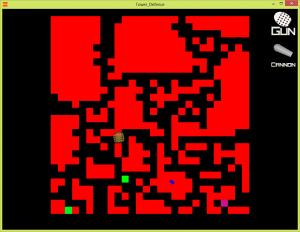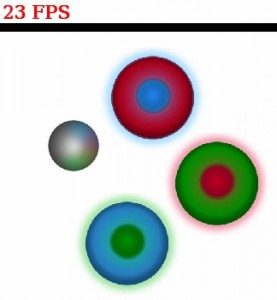Tag: Box2D
Hello once again!
Today I’m happy to offer some code from my early prototypes of Tower Defence, build 13 from September/October ’12 if anyone is pedantic enough to want to know. It’s super basic: No maze generating algorithms yet, not much in the way of gameplay. A random maze is created (i.e, each map tile is 50/50 whether its walkable or not), start and end points generated and a route found between them using A*, and an “enemy” (green square) moves along the path. You can create a single weapon type – the gun – which fires very slow moving bullets at the enemy.
This code also contains remnants of my quick and dirty collision system, although Box2D is actually running the show.

Continue reading “Tower Defence prototype code”
Hello again, today I bring you another lesson learnt.
When you choose Haxe for a project there are a wealth of 2D physics engines available, mostly ports of other popular engines, like Box2D. There are actually a few distinct ports to Haxe of various versions of B2D, but the most up-to-date and the one I’ve been using is Joshua Granick’s port of 2.1a. You can get it from Haxelib by opening a command prompt / terminal and running “haxelib install box2d”
In brief, it’s fantastic. Once you get a handle on how it works and where all the bits you want to use are it’s pretty simple, a far cry from the engine I initially experimented with – Physaxe – which was basically 20 pages of pure maths disguised as classes and functions! But there are some small issues I’ve run across while using it, and here comes the latest (and its solution, I wouldn’t leave you hanging!)
Continue reading “The intricacies of removing bodies in Box2D”
In my new tower defence project I need to know when certain things are touching, or when object A is within range of object B, and other nonsenses like that. It seems perverse now, but the first time I had to implement collision code a few years ago I didn’t know why the computer couldn’t TELL there was a collision: The blue circle is halfway-inside the red square, surely that’s obvious? But implement I did, and it was horrible and rough, but for that project it didn’t matter at all.
In the early days of this project I implemented a collision system again with just two shape types: Rectangle and circle. It worked well enough, but the performance was awful — I had time to knock together a few arrays and an update loop, but more advanced stuff like knowing which objects could be safely ignored to speed the whole process up takes time to write and test. Having experience with it previously, I ran back to Box2D, dropping the source in to my project so I could begin prodding.
Pong was a short project attempting to clean up my code base for Pinball, as well as rectify several nasty and hard-to-catch bugs who were only really present because Pinball was based directly on the first Haxe code I’d written which as you can guess, wasn’t totally solid. Eventually the need to rewrite a lot of my core code is what made me cease development on Pinball, although Pong did help resolve several issues. It was also built while Atari was running it’s Pong Indie Developer Challenge, so I wanted to experiment with some alternate game modes, hence the strange selection of gametypes on offer (multiball is still my favourite).
Continue reading “Pong project”
Pinball was my first real project with NME, and influenced everything I’m doing with it now. It was very much an experimental project to gain understanding of how it all worked, and in retrospect, I wrote a lot of very heavy, slow code that was unnecessary.

Continue reading “Pinball”